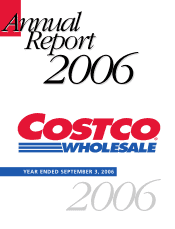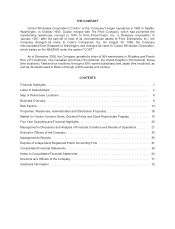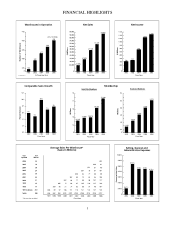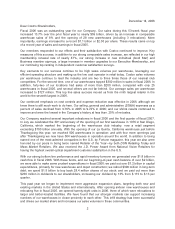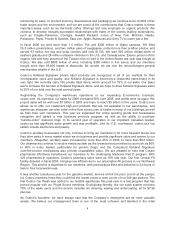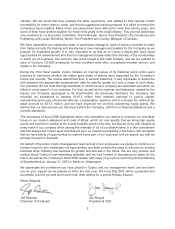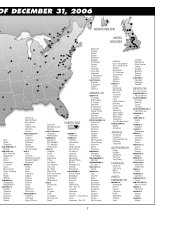Costco 2006 Annual Report Download - page 10
Download and view the complete annual report
Please find page 10 of the 2006 Costco annual report below. You can navigate through the pages in the report by either clicking on the pages listed below, or by using the keyword search tool below to find specific information within the annual report.BUSINESS OVERVIEW
We operate membership warehouses based on the concept that offering our members very low prices
on a limited selection of nationally branded and selected private label products in a wide range of
merchandise categories will produce high sales volumes and rapid inventory turnover. This rapid
inventory turnover, when combined with the operating efficiencies achieved by volume purchasing,
efficient distribution and reduced handling of merchandise in no-frills, self-service warehouse facilities,
enables us to operate profitably at significantly lower gross margins than traditional wholesalers, mass
merchandisers, supermarkets and supercenters.
We buy the majority of our merchandise directly from manufacturers and route it to a cross-docking
consolidation point (“depot”) or directly to our warehouses. Our depots receive container-based
shipments from manufacturers and reallocate these goods for combined shipment to our individual
warehouses, generally in less than twenty-four hours. This maximizes freight volume and handling
efficiencies, thereby lowering our receiving costs by eliminating many of the costs associated with
multiple step distribution channels, which include purchasing from distributors as opposed to
manufacturers, use of central receiving, storing and distributing warehouses, and storage of
merchandise in locations off the sales floor.
Because of our high sales volume and rapid inventory turnover, we generally have the opportunity to
sell and be paid for inventory before we are required to pay many of our merchandise vendors, even
though we take advantage of early payment discounts. As sales increase and inventory turnover
becomes more rapid, a greater percentage of inventory is financed through payment terms provided by
vendors rather than by our working capital.
Our typical warehouse format averages approximately 140,000 square feet. Floor plans are designed
for economy and efficiency in the use of selling space, the handling of merchandise and the control of
inventory. Because shoppers are attracted principally by the availability of low prices, our warehouses
need not be located on prime commercial real estate sites or have elaborate facilities. By strictly
controlling the entrances and exits of our warehouses and using a membership format, we have limited
inventory losses to less than two-tenths of one percent of net sales in each of the last three fiscal
years—well below those of typical discount retail operations.
We generally limit marketing and promotional activities to new warehouse openings, occasional direct
mail marketing to prospective new members and direct marketing programs (such as the Costco
Connection) to existing members promoting selected merchandise. These practices result in lower
marketing expenses as compared to typical retailers, discount retailers and supermarkets. In
connection with new warehouse openings, our marketing teams personally contact businesses in the
area that are potential wholesale members. These contacts are supported by direct mailings during the
period immediately prior to opening. Potential Gold Star (individual) members are contacted by direct
mail or by providing membership offerings to be distributed through employee associations and other
entities. After a membership base is established in an area, most new memberships result from
word-of-mouth advertising, follow-up messages distributed through regular payroll or other
organizational communications to employee groups and ongoing direct solicitations to prospective
Business and Gold Star members.
Our warehouses generally operate on a seven-day, 69-hour week. Generally, warehouses are open
weekdays between 10:00 a.m. and 8:30 p.m., with earlier closing hours on the weekend. Gasoline
operations generally have extended hours. Because the hours of operation are shorter than those of
traditional retailers, discount retailers and supermarkets and due to other operational efficiencies
inherent in a warehouse-type operation, labor costs are lower relative to the volume of sales.
Merchandise is generally stored on racks above the sales floor and displayed on pallets containing
large quantities of each item, thereby reducing labor required for handling and stocking.
8

